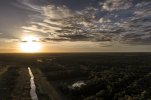You are using an out of date browser. It may not display this or other websites correctly.
You should upgrade or use an alternative browser.
You should upgrade or use an alternative browser.
Air 2s My First .DNG Edit in Photoshop 2020
- Thread starter VenomXts
- Start date
BobaFut
Well-Known Member
If you have an Adobe subscription (or just don't mind spending the extra money), I'd recommend Lightroom over Photoshop for general photo editing. The workflow, especially with raw files, is so much better if you're just doing slider-type adjustments (as opposed to a lot of brush work). And as you've probably noticed, the amount of detail you can save from shadows and highlights in a raw file is so much better and gives you a larger margin of error...some say raw in photography is a crutch, but for drones you just don't have quite the same level of control over the camera that is there in regular photography, so having that margin is really nice.
Eagle Eye 62
Well-Known Member
I agree on using Lightroom over Photoshop. I would also recommend using 5 bracket (HDR) exposures to give yourself more dynamic range.
retiredNH
Well-Known Member
Used to do a lot of bracketing with my mini 2, but found that the raw dng files on the 2s have enough dynamic range that bracketing is a waste of time and space, at least for me. YMMV. One can only experiment and find what works for one's own personal shooting style.I agree on using Lightroom over Photoshop. I would also recommend using 5 bracket (HDR) exposures to give yourself more dynamic range.
Hey Venom!Literally the first image I have ever done in the program using a .DNG.
I normally don't shoot in it or RAW but I might more.. Stole this from a pano folder where the pano failed due to wind.
View attachment 156220
Full Disclosure, I normally use Snapseed to do my editing for photo's just uses the advanced modes.
If you shoot a lot of landscapes with bright skies and dark foregrounds (think Sunrise, Sunset) you will soon learn that the high dynamic range (brightest to darkest) will be too great to develop both sky and foreground properly, and it is the sky that wins the battle every time. The foreground comes out dark without details. The sensor is overpowered by the light of the sun.
In Photoshop, using the masking tool, you can separate the processing of the two by masking and processing the sky separately from the foreground. Here is what I mean. Shooting in RAW (DNG) allows the details in the dark areas to be developed).
I know, I know....Adobe sucks so save the rants everyone.
Feel free to write me on a private conversation if you want any help.
Dale
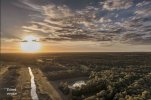
retiredNH
Well-Known Member
Sure retired NH!Dale D, how would your edit compare to just lifting the shadows?
Others might note that the new masking tools in the latest edition of LR Classic mean you probably would not need to go to Photoshop to get this masked edit? Dale, care to comment?
I'd be happy to comment.
On October 19th, Adobe just dropped a new version of Photoshop 2023 and a major upgrade to Lightroom and Camera RAW (2023) with amazing new AI (artificial intelligence) features. These AI features intuitively are able to isolate sky, foreground, objects, individual faces, multiple faces, etc. You can isolate any single part of your image and edit it without affecting other parts. It is truly AI (Artificial intelligence). The engine is the same exact engine in Photoshop and Lightroom. It is rapidly becoming a lifesaver for me. In the attached photo, I did five (5) separate edits!!! The sky, the foreground, the right side building, under the bridge, etc. The new Photoshop AI for 2023 allows separate categories in the masking tool! You can select and individuallly edit people, objects, background, face or faces,sky, gradients, etc. Here is a link and a photo where I just edited four or 5 separate parts of the image!!!!
Attachments
Sure retired NH!Dale D, how would your edit compare to just lifting the shadows?
Others might note that the new masking tools in the latest edition of LR Classic mean you probably would not need to go to Photoshop to get this masked edit? Dale, care to comment?
I'd be happy to comment.
On October 19th, Adobe just dropped a new version of Photoshop 2023 and a major upgrade to Lightroom and Camera RAW (2023) with amazing new AI (artificial intelligence) features. These AI features intuitively are able to isolate sky, foreground, objects, individual faces, multiple faces, etc. You can isolate any single part of your image and edit it without affecting other parts. It is truly AI (Artificial intelligence). The engine is the same exact engine in Photoshop and Lightroom. It is rapidly becoming a lifesaver for me. In the attached photo, I did five (5) separate edits!!! The sky, the foreground, the right side building, under the bridge, etc. The new Photoshop AI for 2023 allows separate categories in the masking tool! You can select and individuallly edit people, objects, background, face or faces,sky, gradients, etc. Here is a link and a photo where I just edited four or 5 separate parts of the image!!!!
Sure retired NH!Dale D, how would your edit compare to just lifting the shadows?
Others might note that the new masking tools in the latest edition of LR Classic mean you probably would not need to go to Photoshop to get this masked edit? Dale, care to comment?
I'd be happy to comment.
On October 19th, Adobe just dropped a new version of Photoshop 2023 and a major upgrade to Lightroom and Camera RAW (2023) with amazing new AI (artificial intelligence) features. These AI features intuitively are able to isolate sky, foreground, objects, individual faces, multiple faces, etc. You can isolate any single part of your image and edit it without affecting other parts. It is truly AI (Artificial intelligence). The engine is the same exact engine in Photoshop and Lightroom. It is rapidly becoming a lifesaver for me. In the attached photo, I did five (5) separate edits!!! The sky, the foreground, the right side building, under the bridge, etc. The new Photoshop AI for 2023 allows separate categories in the masking tool! You can select and individuallly edit people, objects, background, face or faces,sky, gradients, etc. Here is a link and a photo where I just edited four or 5 separate parts of the image!!!!
I have had Adobe for many, many years. I can afford it and I love it. Don't really want to get into the Adobe discussion for now.If you have an Adobe subscription (or just don't mind spending the extra money), I'd recommend Lightroom over Photoshop for general photo editing. The workflow, especially with raw files, is so much better if you're just doing slider-type adjustments (as opposed to a lot of brush work). And as you've probably noticed, the amount of detail you can save from shadows and highlights in a raw file is so much better and gives you a larger margin of error...some say raw in photography is a crutch, but for drones you just don't have quite the same level of control over the camera that is there in regular photography, so having that margin is really nice.
IF you have Lightroom it comes with Photoshop as a package! (or vice versa). The Photo package is $9.99 a month for both.
This a great video the new AI masking tool of Light room and Photo shopDale D, how would your edit compare to just lifting the shadows?
Others might note that the new masking tools in the latest edition of LR Classic mean you probably would not need to go to Photoshop to get this masked edit? Dale, care to comment?
Dale
maggior
Well-Known Member
First off, great job to the OP. Like Dale suggested, I think brightening up the bottom right portion of the image would improve it even further. Taming the harsh sun is certainly a big step!
Lightroom with a RAW image to work with is just amazing. I don't see it as a crutch, I see it as a tool where you can fix exposure issues that would be impossible to do in camera (drone camera in this case). On top of evening out the exposure and bringing out washed out colors, you can be creative with color grading to present a particular mood or subtly enhance what is already there.
This is a shot I took with my A2S in the late afternoon and the lighting was rather harsh and made it impossible to expose the full image properly in the drone. It is quite satisfying to be able to draw a pleasant looking image out of a rather washed out looking one or a dark underexposed one.
This is the original which is mostly underexposed to compensate for the bright sun low in the sky off to the right.
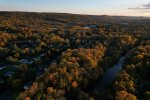
Here's the result with lightroom where I used a bunch of masks (mostly if not all radial gradients) to adjust the exposure in different parts of the image (along with some color enhancements). As nice as the original was, I find the resulting image much more pleasant. I also cropped to 16:9.
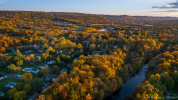
Lightroom with a RAW image to work with is just amazing. I don't see it as a crutch, I see it as a tool where you can fix exposure issues that would be impossible to do in camera (drone camera in this case). On top of evening out the exposure and bringing out washed out colors, you can be creative with color grading to present a particular mood or subtly enhance what is already there.
This is a shot I took with my A2S in the late afternoon and the lighting was rather harsh and made it impossible to expose the full image properly in the drone. It is quite satisfying to be able to draw a pleasant looking image out of a rather washed out looking one or a dark underexposed one.
This is the original which is mostly underexposed to compensate for the bright sun low in the sky off to the right.

Here's the result with lightroom where I used a bunch of masks (mostly if not all radial gradients) to adjust the exposure in different parts of the image (along with some color enhancements). As nice as the original was, I find the resulting image much more pleasant. I also cropped to 16:9.

maggior
Well-Known Member
The new AI masking is pretty amazing. Since I don't do portrait photography, the object detection will be most useful to me.This a great video the new AI masking tool of Light room and Photo shop
Dale
Maggior:The new AI masking is pretty amazing. Since I don't do portrait photography, the object detection will be most useful to me.
I am thrilled that you are using the Masking programs that Adobe is using. I would have used the LINEAR gradient because it is less work than multiple radial gradients.
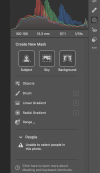
DaleThe new AI masking is pretty amazing. Since I don't do portrait photography, the object detection will be most useful to me.
So after spending some time with this thread, I decided to take my M3 outside for a hyperlapse sunset. Here is a single frame out-take before and after Adobe Photoshop Masking. In the un-edited shot, the brightness of the sun overpowers the foreground which is grossly under exposed. AFTER the masking, (I developed the sky first), here is what the image looks like. The foreground detail is amazing.Maggior:
I am thrilled that you are using the Masking programs that Adobe is using. I would have used the LINEAR gradient because it is less work than multiple radial gradients. View attachment 156267
Dale
Any question which image you would prefer?
Dale
Dale
Attachments
maggior
Well-Known Member
I use linear gradients to adjust a big swath of the image from one of the edges. I use radial gradients to make adjustments that are perhaps in the middle of the photo to get very specific about where I want to tweak. Even subtle tweaks can make a significant difference.Maggior:
I am thrilled that you are using the Masking programs that Adobe is using. I would have used the LINEAR gradient because it is less work than multiple radial gradients. View attachment 156267
Dale
Luminance and color masks can be handy too.
maggior
Well-Known Member
The edited version for sure is better. Amazing what can be recovered from under exposure. Sometimes it can look a bit artificial though. Depends on the look you are going for.So after spending some time with this thread, I decided to take my M3 outside for a hyperlapse sunset. Here is a single frame out-take before and after Adobe Photoshop Masking. In the un-edited shot, the brightness of the sun overpowers the foreground which is grossly under exposed. AFTER the masking, (I developed the sky first), here is what the image looks like. The foreground detail is amazing.
Any question which image you would prefer?
Dale
Dale
I am presently processing the timelapse/hyperlapse sunset using the masking tools that are included in the LRTimelapse software. I will be incorporating it in an upcoming video.The edited version for sure is better. Amazing what can be recovered from under exposure. Sometimes it can look a bit artificial though. Depends on the look you are going for.
Dale
Similar threads
- Replies
- 17
- Views
- 516
- Replies
- 15
- Views
- 2K
- Replies
- 9
- Views
- 2K
- Replies
- 4
- Views
- 533
- Replies
- 7
- Views
- 1K
DJI Drone Deals
New Threads
-
-
Air 3 Stirling Castle on a cold & slightly misty night
- Started by Coconut Island Drones
- Replies: 0
-
Air 3 Kite Surfing Fuerteventura / Luna Landscape New Version
- Started by Pacefast
- Replies: 0
-
-
Members online
Total: 472 (members: 10, guests: 462)




